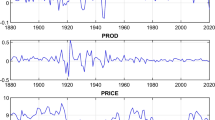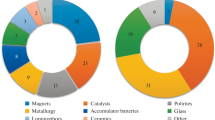Abstract
Rare earth elements govern today’s high-tech world and are deemed to be essential for the attainment of sustainable development goals. Since the 1990s, these elements have been predominantly supplied by one single actor, China. However, due to the increasing relevance of their availability, the United States, who imports 80% of its rare earths from China, recently announced its plan to (re-)enter the rare earths supply market. This paper analyzes the strategic interactions among these two countries in open-loop and Markovian strategy spaces. Particular interest is devoted to the impact of heterogeneous supply concepts on (1) the theoretical optimal timing for the United States (U.S.) to enter the non-renewable resource market; (2) China’s optimal supply reaction to the U.S.’ entry announcement; (3) the central planner outcome; and (4) the profitability of the suppliers’ extraction behavior. By setting up a continuous-time differential game model, we show that in the absence of arbitrage opportunity, (1) the U.S. should always postpone the production launch until its rare earths reserves coincide with those of China; (2) China’s monopolistic supply is not shaped by the selected strategy; (3) while the duopolistic Markovian behavior is initially more lucrative than open-loop commitment, the opposite situation emerges as the competition proceeds; and (4) on balance, both countries are financially better off when committing to an open-loop supply path.


Similar content being viewed by others
Availability of Data and Material
Not applicable.
Code Availability
Mathlab was used for numerical illustration and the code is available.
Notes
The 15 lanthanides (at. no. 57–71) plus scandium (at. no. 21) and yttrium (at. no. 39).
Following the definition of [36], “the backstop technology is a set of processes that (1) is capable of meeting the demand requirements, and (2) has a virtually infinite resource base.”
For example, bastnaesite, monazite, xenotime, or loparite. Note that the concentration and proportion of the individual elements vary with the type of mineral and the deposit’s geographical location.
Especially on neodymium and dysprosium [18].
A more detailed account of the related literature is presented in the next section.
The presented supply discrepancies correspond to a situation where \(\frac{R_A(0)}{R_A(0)+R_C(0)}=\frac{1}{4}\).
References
Federal Register. (2017). Presidential executive order on a federal strategy to ensure secure and reliable supplies of critical minerals.
Connelly, N. G., Hartshorn, R. M., Damhus, T., & Hutton, A. T. (2005). Nomenclature of inorganic chemistry: IUPAC recommendations 2005. Royal Society of Chemistry.
Goodenough, K. M., Wall, F., & Merriman, D. (2018). The rare earth elements: demand, global resources, and challenges for resourcing future generations. Natural Resources Research, 27(2), 201–216.
Schlinkert, D., & van den Boogaart, K. G. (2015). The development of the market for rare earth elements: Insights from economic theory. Resources Policy, 46, 272–280.
Binnemans, K., Jones, P. T., Van Acker, K., Blanpain, B., Mishra, B., & Apelian, D. (2013). Rare-earth economics: The balance problem. JOM, 65(7), 846–848.
Neary, C., & Highley, D. (1984). The economic importance of the rare earth elements. Developments in Geochemistry, 2, 423–466.
Massari, S., & Ruberti, M. (2013). Rare earth elements as critical raw materials: Focus on international markets and future strategies. Resources Policy, 38(1), 36–43.
Zhou, B., Li, Z., & Chen, C. (2017). Global potential of rare earth resources and rare earth demand from clean technologies. Minerals, 7(11), 203.
Dudley, B. (2017). BP energy outlook: 2017 edition. (pp. 1–103).
Alonso, E., Sherman, A. M., Wallington, T. J., Everson, M. P., Field, F. R., Roth, R., & Kirchain, R. E. (2012). Evaluating rare earth element availability: A case with revolutionary demand from clean technologies. Environmental Science & Technology, 46(6), 3406–3414.
Gordon, B., Haxel, J. B. H., Orris, & G. J. (2002). Rare earth elements: Critical resources for high technology. US Geological Survey, 1–4.
Chakhmouradian, A. R., & Wall, F. (2012). Rare earth elements: minerals, mines, magnets (and more). Elements, 8(5), 333–340.
Krishnamurthy, N., & Gupta, C. K. (2015). Extractive metallurgy of rare earths. CRC Press.
Mancheri, N. A. (2015). World trade in rare earths, Chinese export restrictions, and implications. Resources Policy, 46, 262–271.
Trujillo, E. (2015). China-Measures related to the exportation of rare earths, tungsten, and molybdenum. American Journal of International Law, 109(3), 616–623.
British Geological Survey. (2015). Risk list 2015. (pp. 1–8).
Chapman, A., Arendorf, J., Castella, T., Thompson, P., Willis, P., Espinoza, L., Klug, S., & Wichmann, E. Study on critical raw materials at EU level. Oakdene Hollins, 1–158.
Chu, S. (2010). Critical materials strategy. US Department of Energy, 1–165.
Hornby, L., & Sanderson, H. (2019). Rare earths: Beijing threatens a new front in the trade war. Financial Times.
Partington, R. (2019). Global markets fall as China prepares to hit back at US in trade war. The Guardian.
US Department of Commerce. (2019). A federal strategy to ensure secure and reliable supplies of critical minerals.
Reinganum, J. F., & Stokey, N. L. (1985). Oligopoly extraction of a common property natural resource: The importance of the period of commitment in dynamic games. International Economic Review, 161–173.
Dockner, E. J., Jorgensen, S., Van Long, N., & Sorger, G. (2000). Differential games in economics and management science. Cambridge University Press.
Shahidehpour, M., Yamin, H., & Li, Z. (2003). Market operations in electric power systems: forecasting, scheduling, and risk management. John Wiley & Sons.
Liski, M., & Montero, J. P. (2014). Forward trading in exhaustible-resource oligopoly. Resource and Energy Economics, 37, 122–146.
Clemhout, S., & Wan, H. (1991). Environmental problem as a common property resource game. In Dynamic Games in Economic Analysis (pp. 132–154). Springer.
Dockner, E. J., & Sorger, G. (1996). Existence and properties of equilibria for a dynamic game on productive assets. Journal of Economic Theory, 71(1), 209–227.
Van Long, N., Shimomura, K., & Takahashi, H. (1999). Comparing open-loop with Markov equilibria in a class of differential games. The Japanese Economic Review, 50(4), 457–469.
Hotelling, H. (1931). The economics of exhaustible resources. Journal of political Economy, 39(2), 137–175.
Salant, S. W. (1976). Exhaustible resources and industrial structure: A nash-cournot approach to the world oil market. Journal of Political Economy, 84(5), 1079–1093.
Ulph, A. M., & Folie, G. (1980). Exhaustible resources and cartels: An intertemporal nash-cournot model. Canadian Journal of Economics, 645–658.
Benchekroun, H., & Withagen, C. (2012). On price taking behavior in a nonrenewable resource cartel-fringe game. Games and Economic Behavior, 76(2), 355–374.
Zou, B. (2016). Differential games with (A) symmetric players and heterogeneous strategies. Journal of Reviews on Global Economics, 5, 171–179.
Van Long, N. (2011). Dynamic games in the economics of natural resources: a survey. Dynamic Games and Applications, 1(1), 115–148.
Gilbert, R. J. (1978). Dominant firm pricing policy in a market for an exhaustible resource. The Bell Journal of Economics, 385–395.
Nordhaus, W. D., Houthakker, H., & Solow, R. (1973). The allocation of energy resources. Brookings Papers on Economic Activity, 3, 529–576.
Newbery, D. M. (1981). Oil prices, cartels, and the problem of dynamic inconsistency. The Economic Journal, 91(363), 617–646.
Groot, F., Withagen, C., & De Zeeuw, A. (2003). Strong time-consistency in the cartel-versus-fringe model. Journal of Economic Dynamics and Control, 28(2), 287–306.
Benchekroun, H., Halsema, A., & Withagen, C. (2009). On nonrenewable resource oligopolies: The asymmetric case. Journal of Economic Dynamics and Control, 33(11), 1867–1879.
Lewis, T. R., & Schmalensee, R. (1980). On oligopolistic markets for nonrenewable natural resources. The Quarterly Journal of Economics, 95(3), 475–491.
Loury, G. C. (1986). A theory of’oil’igopoly: Cournot equilibrium in exhaustible resource markets with fixed supplies. International Economic Review, 27(2), 285–301.
Herfindahl, O. C. (1967). Depletion and economic theory. Extractive Resources and Taxation, 63–90.
Eswaran, M., & Lewis, T. (1985). Exhaustible resources and alternative equilibrium concepts. Canadian Journal of Economics, 459–473.
Salo, S., & Tahvonen, O. (2001). Oligopoly equilibria in nonrenewable resource markets. Journal of Economic Dynamics and Control, 25(5), 671–702.
Gilbert, R. J., Goldman, S. M., et al. (1978). Potential competition and the monopoly price of an exhaustible resource. Journal of Economic Theory, 17(2), 319–331.
Dasgupta, P., Gilbert, R. J., & Stiglitz, J. E. (1982). Invention and innovation under alternative market structures: The case of natural resources. The Review of Economic Studies, 49(4), 567–582.
Stiglitz, J. E. (1976). Monopoly and the rate of extraction of exhaustible resources. The American Economic Review, 66(4), 655–661.
Stiglitz, J. E., & Dasgupta, P. (1982). Market structure and resource depletion: A contribution to the theory of intertemporal monopolistic competition. Journal of Economic Theory, 28(1), 128–164.
Stiglitz, J. E., & Dasgupta, P. (1981a). Market structure and resource extraction under uncertainty. The Scandinavian Journal of Economics, 83(2), 318–333.
Stiglitz, J. E., & Dasgupta, P. (1981b). Resource depletion under technological uncertainty. Econometrica, 49(1), 85–104.
Harris, C., Howison, S., & Sircar, R. (2010). Games with exhaustible resources. SIAM Journal on Applied Mathematics, 70(7), 2556–2581.
Gerlagh, R., & Liski, M. (2014). Cake-eating with private information.
Kamien, M. I., & Schwartz, N. L. (1981). Dynamic optimization: The calculus of variations and optimal control in economics and management. Elsevier North-Holland Publishing Co.
Benchekroun, H., & Gaudet, G. (2003). On the profitability of production perturbations in a dynamic natural resource oligopoly. Journal of Economic Dynamics and Control, 27(7), 1237–1252.
Gaudet, G. (2007). Natural resource economics under the rule of hotelling. Canadian Journal of Economics, 40(4), 1033–1059.
Funding
Not applicable.
Author information
Authors and Affiliations
Contributions
The three authors jointly discuss the research questions, calculation, and writing.
Corresponding author
Ethics declarations
Conflict of Interest
The authors declare no competing interests.
Additional information
Publisher’s Note
Springer Nature remains neutral with regard to jurisdictional claims in published maps and institutional affiliations.
We thank Aguzstin Perez Barahona and Patrice Pieretti for helpful comments.
Appendices
Appendix 1
1.1 Proof Proposition 1
The second-period optimal control problem for both countries is
subject to
and
Since the first constraint of the optimization problem is equivalent to
the Lagrangian is set up as follows:
where \(\lambda _i^{II}(t)\) is the shadow price and \(\alpha _i^{II}\) is the static Lagrange multiplier. The standard first-order conditions (FOCs) are
where the revenue of country \(i=\{A,C\}\) is \(RV_i^{II}(t)=P^{II}(t)q_i^{II}(t)\). Based on the remarks in Subsection 3, it is not optimal for i to exhaust its resources in finite time; thus, \(R_i(T^*)>\int _{T^*}^{t}\!q_i^{II}(\tau )\,\mathrm {d} \tau\), and hence \(\alpha _i^{II}=0\).
The first FOC yields that i’s shadow price \(\lambda _i^{II}(t)\) of its remaining reserve \(R_i(t)\) grows at interest rate r:
The second FOC and the fact that \(\alpha _i^{II}=0\) show that the shadow price does actually correspond to:
Furthermore, since the revenue of country i is
the partial derivative of its revenue function with respect to its supply path is
which yields
where \(i,j=\{A,C\}\) and \(i \ne j\). After rearranging Eq. (43), we find
When integrating Eq. (44) over \([T^*,+\infty )\) and by assuming that over \([T^*,+\infty )\) the total REE reserve is exhausted, as from an economical viewpoint it is not optimal to leave some elements in the deposit (no market value), we get
that is,
Combining (44) and (45) yields
In view of Eq. (46), the price function in (1) is
and the revenue of country C [A] is
so that on the one hand the country i’s marginal revenue corresponds to:
On the other hand, the findings of (42) and (46) imply that the derivative of country C’s revenue function with respect to its supply path leads to:
Combining (49) and (50) yields
and based on Eq. (46), this is
When substituting (47) into (51), we obtain
Integrating Eq. (52) over \([T^*,+\infty )\) yields
After substituting (53) into (52), we find the extraction rate of country C:
which, combined with Eq. (47), yields the duopoly market price of the REE:
Then, by substituting (54) into (46), we get the extraction rate of country A:
Thus, the aggregate revenue for player i is
with \(i=A\), \(R_i(T^*)=R_A(0)\) and \(i=C\), \(R_i(T^*)=R_C^*\). Obviously, the second period revenue difference between the two players only depends on the difference initial reserve at time \(t=T^*\). Nonetheless, given \(0<\alpha <1\), the revenue, via price, decreases with the initial aggregate reserve \(R_A(0)+R_C^*\). Thus, from player A’s point of view, it is more beneficial to wait to enter the supply market as late as possible, such that player C’s reserve decreases sufficiently low to yield higher market price. Then with the same initial reserve, player A can generate higher revenue. In other words, player A would not enter the market when \(R_C(t)>R_A(0)\). Obviously, player C sees the same opportunity and waits for player A to supply the market as early as possible. If at some time T, player C’s reserve, \(R_C(T)<R_A(0)\), player C should stop supply to the market. Otherwise, player C would lose revenue while player A gains, which is an arbitrage opportunity. So \(R_C(T)<R_A(0)\) can not happen either.
As a conclusion, player A enter the market if and only if \(R_C(T)= R_A(0)\).
This finishes the proof. The results are presented in Proposition 1 and its corollary of Subsection 4.1.
Appendix 2
1.1 Proof that \(T^*=0\) is Not Optimal for Player A
In this subsection, we show that \(T^*=0\) can not be optimal. To do so, we first suppose that from the beginning of the game, that is, \(t=0\), player A and C jointly supply to the market. Then, we show that under this assumption, player A’s revenue, denoted as \(\Pi _A^{b}\) from her initial reserve, is lower than the revenue from Proposition 1.
The objective of player i is
subject to
The same calculation under open-loop strategy as the proof of Proposition 1, it follows that the optimal supply of player i is
the market price is
and optimal revenue for player i under the current situation is
Recall, the optimal revenue for player A when enters at \(t=T^*>0\) is
Thus, given the same initial reserve, \(R_A(0), R_C(0)\), and \(0<\alpha <1\), player A faces higher price than earlier entering, that is,
Therefore,
A similar proof can be done for Markovian strategy. As a conclusion, \(T^*=0\) can not happen.
Appendix 3
1.1 Proof of Lemma 1
Recall that the optimal control problem faced by the competitors in the second time period looks as follows:
subject to
and
The stationary Hamilton-Jacobi-Bellman (HJB) equation of the above problem is thus given by
which yields the corresponding first-order condition (FOC)
It follows that
where \(i,j = \{A,C\}\) and \(i \ne j\).
Moreover, given that country i’s Markovian supply strategy \(q_i^{II}\!\!\left( R_i\right)\) depends only on its own reserves \(R_i\) and not on the ones of country j, we can apply the envelope theorem to differentiating both sides of the HJB equation with respect to \(R_i\). This gives
which, based on the dynamic equation of the above problem, can be rewritten as
From Eq. (57) it then follows that
Finally, solving the differential equation of (58) leads to:
where \(W_i'(R_i(T^*))={\mathrm {d} W_i\left( R_i(T^*)\right) \over \mathrm {d} R_i}\), and so
At this point, we can combine the first order condition from the last page and Eq. (60) to find that
which, after rearranging, corresponds to:
Under the assumption that both competitors fully exhaust their initial reserves \(R_i(T^*)\) over the second-period planning horizon because, from an economical viewpoint, it cannot be optimal to leave some REEs in the deposit (no market value), integrating Eq. (61) over \([T^*, +\infty )\) yields
which can also be expressed as
Then, after combining Eqs. (61) and (62), we have
The conjecture that there is no arbitrage opportunity for any of the countries at the entry time \(T^*\) means that
From Eqs. (59) and (63), we obtain that the above no arbitrage condition is satisfied if and only if
Rights and permissions
About this article
Cite this article
Zou, B., Poncin, S. & Bertinelli, L. The U.S.-China Supply Competition for Rare Earth Elements: a Dynamic Game View. Environ Model Assess 27, 883–900 (2022). https://doi.org/10.1007/s10666-022-09819-4
Received:
Accepted:
Published:
Issue Date:
DOI: https://doi.org/10.1007/s10666-022-09819-4
Keywords
- Rare earth elements
- Differential games
- Open-loop strategic Nash equilibrium
- Markovian strategic Nash equilibrium




